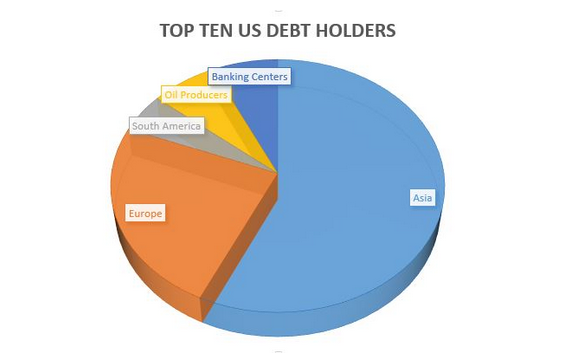Everyone knows the Federal Reserve of the United States is going to raise rates. But when, by how much, and who will be most affected remain questions to be answered. These are the questions that have been nagging the stock market in the face of the Fed decision. Here at Dividend.com we have taken the liberty of breaking down the top ten holders of U.S. debt as well as a few companies that will be most impacted by the rate rise.
Goldman Sachs thinks the fed will wait to raise rates because August economic reports are some of the most fickle of the year and are the most likely to be revised. In addition, a major unspoken concern is the speed at which the Fed will raise rates. According to a recent survey, the Fed is likely to raise rates faster than investors are prepared for. The speed of rate increases could worry the market, and companies with convertible or variable debt structures will be the hardest hit.
As the Fed raises rates, the U.S. dollar will become stronger. Over the past 12 months we have seen a historic run in the USD against almost all other currencies in the world. Countries that own U.S. debt effectively own a hedge against U.S. currency value appreciation. The more U.S. debt a country owns, the less their currency will be impacted by raises in the Fed rates.
However, the relationship between currency strength and U.S. debt holdings can be deceptive. Countries such as Brazil and Japan have been forced to buy U.S. debt in order to prevent a further slide in the value of their currency. These countries are export-driven economies, and concerns in the global economy have raised concerns about their economic engines.
Top Ten Countries That Own U.S. Debt
| Rank | Country | Debt Owned |
|---|---|---|
| 1. | China (Mainland) | $1.27 trillion |
| 2. | Japan | $1.19 trillion |
| 3. | Caribbean Banking Centers | $318.5 billion |
| 4. | Oil Exporters | $296.7 billion |
| 5. | Brazil | $256.3 billion |
| 6. | Ireland | $217.7 billion |
| 7. | Switzerland | $217.7 billion |
| 8. | United Kingdom | $214.7 billion |
| 9. | Belgium | $207.7 billion |
| 10. | Luxembourg | $184.0 billion |
- Total (Top 10): $4.38 trillion
- Grand Total: $6.17 trillion
- % of Grand Total: 70.9%
Notes
- Caribbean Banking Centers: Caribbean Banking Centers include Bonaire, St. Eustatius, and Saba; Bahamas; Bermuda; Cayman Islands; Curacao; Saint Maarten; and Panama.
- Oil Exporters: Oil exporters include Ecuador, Venezuela, Indonesia, Bahrain, Iran, Iraq, Kuwait, Oman, Qatar, Saudi Arabia, the United Arab Emirates, Algeria, Gabon, Libya, and Nigeria.
- United Kingdom includes Channel Islands and Isle of Man.

Asia: 57%
Europe: 24%
South America: 5%
Oil Producers: 7%
Banking Centers: 7%
Largest U.S. Companies with Global Exposure
Largest U.S. Companies with Heavy Exposure to Asia
1. Wynn Resorts (WYNN )
2. Qualcomm (QCOM )
3. Yum! Brands (YUM )
Largest U.S. Companies with Heavy Exposure to Europe
1. Philip Morris (PM )
2. General Electric (GE )
3. Abbott (ABT )
Convertible vs. Variable Debt
The Federal Reserve raising rates will impact convertible and variable debt structures the most. Convertible debt is debt that can be traded for public stock in a company; when rates rise, these notes will be converted into stock and then possibly sold into the market. Variable debt is debt that is tied to the general market rate for debt and as rates rise the rates for variable debt structures will rise as well.
For a company’s stock price, both of these debt structures are negative in a rising-rate environment. Convertible debt has the potential to surprise a market and drop large positions into the market, causing an unexpected and large drop in share price. In a bear market, large unexpected selling can cause a flight of investors which leads to further falls in share price. Variable debt impacts the fundamental growth engine of a company. As rates rise, the company’s cost of debt will rise as well, causing more and more capital to be taken away from growth initiatives and moved towards repaying debt.
Largest Companies with the Highest Concentrations of Variable and Convertible Debt
1. eBay (EBAY )
2. MetLife (MET )
3. General Mills (GIS )
4. Ford (F )
5. McDonalds (MCD )
6. General Motors (GM )
7. Time Warner (TWX)
8. Allergan (AGN )
9. Johnson & Johnson (JNJ )
10. Monsanto (MON )
The Bottom Line
It will be interesting to see what the Fed does with interest rates. Irrespective of whatever they do, the impact of probable interest rate changes in the future is going to be magnified as U.S. debt increases every year.
Image courtesy of Pixomar at FreeDigitalPhotos.net





